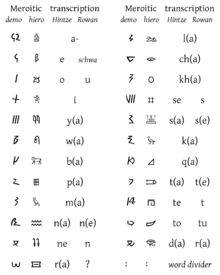Meroitic script
The Meroitic script was used in Nubia in the 3rd century BC. Derived from the Egyptian script . It was used to reproduce the Meroitic language in the empire of Meroe , which existed in the Nile Valley in the northern part of what is now Sudan . The inscriptions in Meroitic script can now be transliterated, but many texts remain misunderstood because the Meroitic language has not yet been deciphered.
Dating
The first attempts at writing can be dated under Arqamani . The oldest Meroitic inscription comes from Queen Shanakdakheto . The last witnesses to this writing probably come from the 5th century AD.
Hieroglyphic and demotic font
Similar to the script in neighboring Egypt, the Meroitic script is available in two fonts, a pictorial hieroglyphic script and a cursive script, also known as "(Meroitic-) demotic". There are no systematic differences between the two fonts, and their characters can be translated directly into one another. Hieroglyphic writing was mainly used for temple inscriptions; their characters are clearly similar to those of the Egyptian hieroglyphs and are also largely derived from them. Italics was the everyday script, it was also preferred for funeral steles and sacrificial tablets and is used on many more texts. The characters in italics may also be based on (italic) Egyptian characters, but this is more difficult to prove here due to the less distinctive forms.
Writing system
The system of the Meroitic script is an Abugida , i.e. it lies between that of a letter script and a syllabic script. Wolfgang Schenkel called it the "Devanagari system". As in the Indian Devanagari script, there is a sign for each consonant, which also has a vowel, in the case of Meroitic a . There are also vowel characters, but usually not for a (a character we transliterate as a only denotes a at the beginning of a word). If a vowel mark is set, it overwrites the inherent a of the preceding consonant. For example, written B is read as ba , written B + I as bi . The way in which consonants were written without a following vowel and whether they even existed in the Meroitic language is controversial.
The Meroitic script has 23 alphabet characters, a word separator (two or three points on top of each other), as well as (only shown in italics :) a series of numerals and a few, rarely occurring symbols, presumably for units of measurement, whose function is still largely unexplained. The values of the numerals could not be finally clarified until 2009 due to a newly found ostracon on which an ancient scribe noted the numbers in ascending order.
Text database
All Meroitic texts are currently collected in a computer database , the Repertoire d'Épigraphie Méroïtique (REM), in Paris . The Meroitic letters have been included in the Unicode standard since version 6.1 : the hieroglyphs under U + 10980 – U + 1099F and the demotic italics under U + 109A0 – U + 109FF .
literature
- Jean Leclant (Ed.): Répertoire d'Épigraphie Méroïtique: corpus des inscriptions publiées. 3 volumes, Diffusion de Boccard: Académie des inscriptions et belles-lettres, Paris 2000, ISBN 978-2-87754-113-8 .
- Jochen Hallof: A Meroitic number ostracon from Qasr Ibrim. In: Contributions to Sudan Research. No. 10, 2009.
- Wolfgang Schenkel: Meroitic script. In: Wolfgang Helck , Eberhard Otto (Hrsg.): Lexikon der Ägyptologie . Harrassowitz, Wiesbaden 1975-ff.
- Francis Breyer: Introduction to Meroitistics (= introductions and source texts for Egyptology. Volume 8). LIT, Berlin 2014, ISBN 978-3-643-12805-8 .
Individual evidence
- ↑ Wolfgang Schenkel: Meroitic script. In: Wolfgang Helck, Eberhard Otto (Hrsg.): Lexikon der Ägyptologie. Wiesbaden 1975ff.
- ↑ Jochen Hallof: A Meroitic number ostracon from Qasr Ibrim. In: Contributions to Sudan Research. 10, 2009.
Web links
- Meroitic character sets: for download (not Unicode compatible)

